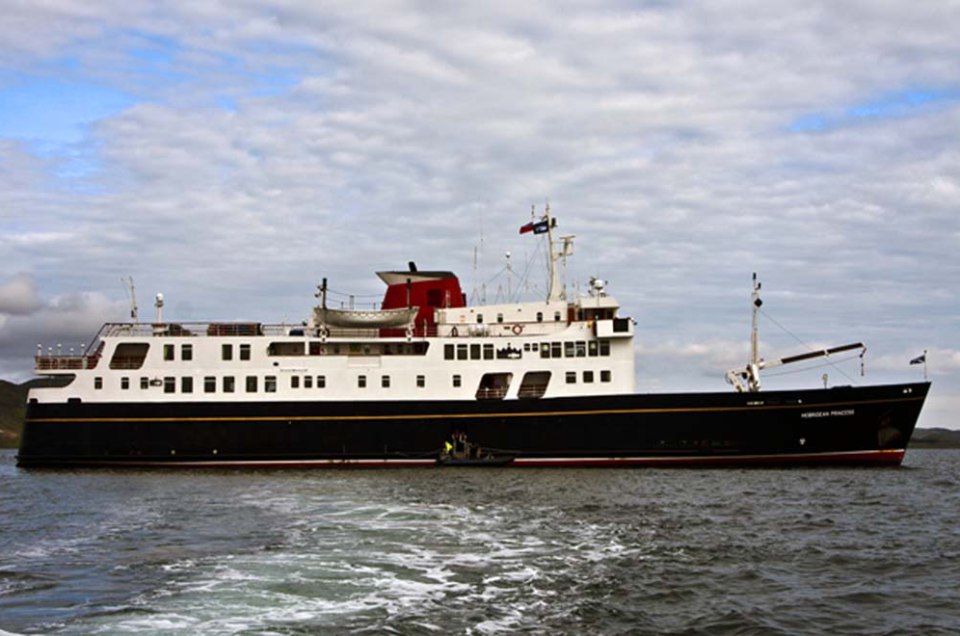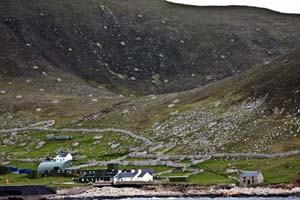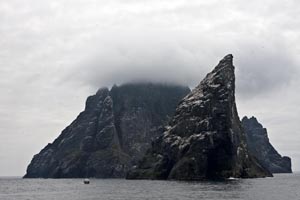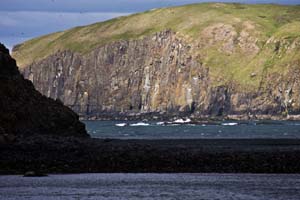Some of our 48 fellow passengers came to explore the Hebrides. Others were birders drawn to the abundant species that frequent Scotland’s western isles. Some came just to spend a week enjoying congenial company and being treated like royalty. We were among the explorers – but that didn’t prevent us from enjoying every moment of the good company and luxury.
The cruise hadn’t started auspiciously back home, when we were packing and asked the travel agent whether my husband really needed to carry formal wear — a necktie-to-shoes outfit he would wear only twice on our entire two-week trip to Scotland. Definitely, she said. He would not be welcome in the ship’s dining room in a dark suit on the formal nights. Period. She even implied that my even asking meant we were probably not the “right” people for the cruise. Way to make us wonder what we were in for!
So we schlepped the formalwear. Of course she was dead wrong. Yes, he was properly dressed, upheld the reputation of American men (he was the only American on board in a tux) and looked like the same gorgeous guy I’d gone to the prom with, but at least 20 percent of the male passengers wore dark suits to the formal occasions and nobody batted an eye. It’s simply not that kind of ship or atmosphere.
What mattered most to the officers and staff — who counted for almost half the people on board — was that everyone was having the best possible time. And everyone was.
We’d chosen this particular cruise because it was one of the few that included St. Kilda, a rarely visited archipelago in the open Atlantic, over 100 miles from Scotland’s coast. Apart from a handful of people at a research station, the islands are inhabited only by birds (in prodigious numbers that include 142,000 puffins) and by shaggy primeval-looking Soay sheep. A row of ruined stone houses is all that’s left of the permanent population, who petitioned to be relocated to the mainland in the 1930s.
And it was thanks to St. Kilda that we learned straightaway what a real luxury cruise could be. Our stop there was scheduled for the end of the cruise, but as we boarded (an experience that set the tone for the week as couple by couple we were piped aboard by the ship’s bagpiper and shown to our staterooms) the officers were busy with weather maps.
A storm heading across the north Atlantic would almost certainly hit later in the week, leaving seas too rough for the ship to enter St. Kilda’s tiny harbor. We all knew that St. Kilda was weather-dependent; that was made clear from the start. Most ships would have simply substituted one of the many other islands. Not the Hebridean Princess. As we sipped single-malt whiskey in the Tiree Lounge before dinner (all drinks and wine are included in the fare), the captain told us that the entire week’s schedule had been turned topsy-turvy. We would beat the storm to St. Kilda, sailing all night and arriving there the following morning.
Of course, this had meant that every other stop had to be changed to re-route us. Dock space in tiny ports, buses and guides for shore excursions, even the delivery of the fresh local strawberries I would finish my dinner with each evening, had all been rescheduled to different days.
After that, nothing surprised us. Not the multi-course meals of locally sourced venison, vegetables and fresh seafood. Nor the picnic hamper that accompanied us to uninhabited Isle Martin, where we spent an afternoon following overgrown lanes of a ghost town. Inside one of the few maintained buildings we found our purser offering hot tea (“would you like that laced with a wee dram?”) and buttery shortbread. A little thing like an uninhabited island shouldn’t interfere with tea time.
We’d known what to look for on Isle Martin, even though we’d chosen not to accompany Rita, the ship’s lecturer/guide on a walk, because she had told us all about the island the previous evening after dinner, and given us annotated maps. She did this each evening, in talks that nobody wanted to miss because they were so witty and packed with information, from historical and cultural background to just plain gossip about the islands we visited.
Much of any cruise’s appeal is the ability to visit multiple destinations without changing hotels rooms. And once we saw our stateroom (Isle of Iona) on the Promenade Deck of the Hebridean Princess, we certainly didn’t want to change. One entire wall was a window, faced by two comfortable chairs, from which we could view the passing scenery or read a good book from the ship’s well-stocked library. The king-sized bed was dressed in fine-count linens and a down comforter, with ample pillows (and good bedside lights) in case we should prefer to read in bed. A long desk/bureau/dressing table gave us plenty of surface and storage space, with drawers for our clothes, as well as a refrigerator that was kept stocked throughout the voyage. The bathroom had a tub even larger than my deep Victorian claw-foot at home, with a thermostat-controlled shower. Luxury indeed.
Isle of Iona was handy to the café-style Skye Deck, where pre-dinner drinks were served on warm evenings and coffee/tea were available as we sailed. Above, the Boat Deck was furnished with lounge chairs for those in search of sun. With a forward view over the bow, the Tyree Lounge was big enough to hold all 50 passengers comfortably for afternoon tea, cocktail hour or after-dinner drinks and coffee as we previewed the next day’s adventures. Smaller seating areas were scattered along the sides of the ship, with views of the passing sea and islands. The birders chose these for their wide-angle perspective, and I sought them out for information when I was curious about some winged creature.
Each day brought at least one island or mainland excursion, more often two. After St. Kilda, we explored Barra to see the atmospheric ruins of a Norse-era stone chapel and a little castle that forms an island of its own in Castle Bay. On the Isle of Lewis we shopped for Harris tweeds in a hidden shop that Rita took us to, after walking among the Bronze Age Standing Stones of Callanish and climbing the stone tower of ancient Carloway Broch. We satisfied the gardeners among us with a morning’s wandering through Inverewe Gardens, and at Ullapool crossed the gaping chasm of Corrieshalloch Gorge on a swinging footbridge. Iona was a highlight, even though I’d been there before, with its lonely ruined 13th-century cloisters and giant Celtic crosses.
On these trips ashore we were invited to stop at the local tearoom, where our tea and cakes were courtesy of the ship, as were all admission fees and tips to guides and drivers – and to the ship staff. In fact, apart from our little shopping spree at the tweed shop we never pulled out a wallet from the time we boarded until we bought our tickets back to Glasgow at the train station in Oban. When Hebridean Cruises says all-inclusive, they mean all.



